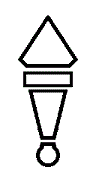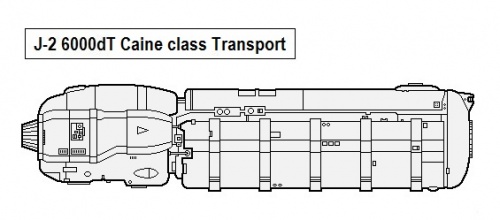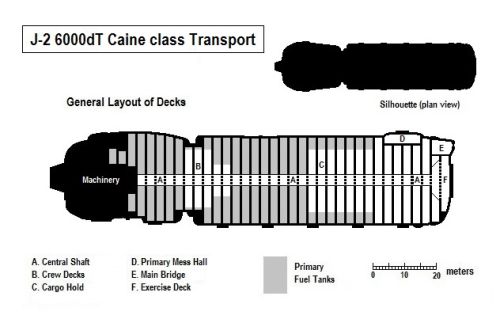Caine class Troop Transport
| Caine class Troop Transport | |
|---|---|
 Distant Fringe vessel. | |
| Type: AC Clipper | |
| Category | BCS |
| Size | 6,000 Tons |
| Hull Configuration | Cylinder Hull |
| Streamlining | Partially Streamlined Hull |
| Tech Level | TL–11 |
| Engineering | |
| Computer | Model 5/fib |
| Jump | J-2 |
| Maneuver | 2 G |
| Armaments | |
| Hardpoints | 60 |
| Accommodations | |
| Staterooms | 250 |
| Low Berths | 100 |
| Personnel | |
| Crew | 70 |
| Officers | 14 |
| Enlisted | 56 |
| High/Mid Passengers | 200 |
| Low Passengers | 100 |
| Payload | |
| Cargo | 220 Tons |
| Fuel tank | 3,180 Tons |
| Carried craft | 20 20T Marrel Veckor class Lifeboat |
| Construction | |
| Construction Time | 40 Months |
| Origin | Distant Fringe |
| Price | |
| Cost | MCr3,333.104 |
| Architect fee | MCr32.882 |
| Statistics | |
| Universal Ship Profile | MN-F3222E2-090000-00000-2 |
| Images | |
| Blueprint | No |
| Illustration | Yes |
| Source | |
| Canon | Unpublished, fan design |
| Designer | Ronald B. Kline Jr. |
| Design System | High Guard |
| Era | 1105 |
| Reference | Fan: Ronald B. Kline, Jr. |
The Caine class Troop Transport is a TL–11 long-range passenger and cargo transport vessel.
- Please also see AAB article: Ships of the Distant Fringe.
- Please also see AAB article: Warships of the Distant Fringe.
Description (Specifications)[edit]
The Caine class are long-range paramilitary transports and carry enough internal fuel for two Jump-2s and a reserve Jump-1. They can be fitted with drop tanks as needed in order to cross larger rift zones. The design includes scoops and onboard purification for wilderness refueling, should that opportunity present itself. The craft is capable of 2-G acceleration giving good performance within the gravity wells of most gas giants.
The vessel is fitted with 100 low berths and has sufficient accommodations to house 100 middle passengers and 100 high passengers. It is fitted with a pair of Model/5fib Computers, a remnant of its paramilitary origins and former role as a troop transport. The thick bulkheads and hatches are utilitarian and the entire vessel lacks the style and grace of similar purpose-built liners. It carries twenty 20 dTon Marrel Veckor class Lifeboats. ODS class vessels have multiple hardpoints but are not routinely armed.
Image Repository[edit]
- A side view of a Caine class Troop Transport, a military combat transport used by the Bright Conclave.

General Description[edit]
The Caine class Troop Transport is a partially streamlined cylinder with a mean diameter of 28 meters and a length of around 130 meters. Some elements of the hull are narrower and some are wider, giving the vessel a total enclosed volume of approximately 81,000 cubic meters.
Much of the interior space is given over to the vessels large fuel tanks, which form the majority of the central and rear sections of the ship, though access ways and workstations are located among them. The cargo hold includes the cryogenic (low berth) section. Working sections of the vessel such as the laundry, the galleys and general crew quarters are located aft. Senior officers are accommodated forward, close to the bridge, while stewards have rooms close to passenger cabins. Middle passage accommodations are found in the less desirable midsection of the vessel while first class cabins are located forward. There is a primary mess hall and an exercise deck.

A basic deck plan of the vessel indicating the general layout and positioning of major elements. The vessel has 36 vertical decks.
Basic Ship Characteristics[edit]
Following the Imperial Navy and IISS Universal Ship Profile and data, additional information is presented in the format shown here. The small craft factor indicates the number of squadrons (...of ten subcraft) carried on the ship. Tonnage on the universal ship profile is shown in kilotons (...thousands of tons) where necessary. [1]
| Basic Ship Characteristics [2] | ||
|---|---|---|
| No. | Category | Remarks |
| 1. | Tonnage / Hull | The Caine class Troop Transport is constructed using a 6000 dTon hull built in a cylindrical configuration. The hull is partially streamlined, giving a reasonable atmospheric performance that is fundamentally reliant on its gravitic systems.
|
| 2. | Crew | Total Crew Complement: x70
x9 Command, x9 Engineering, x7 Gunners, and x18 Service Crew: these double up as flight crew for the vessel's intrinsic subcraft as required. In addition, the vessel carries x2 Medics. Accommodations
There are 100 Low Berths, tended by the ship's Medics and properly trained staff. Accessible areas of the hull are fitted with grav plates and inertial compensators and have full life support and environmental systems.
|
| 3. | Performance | The vessel mounts a DeVoss-type Jump-2 drive, a Maneuver-2 drive and a Power Plant-2, giving performance of jump-2, 2-G acceleration, and producing 120 Energy Points. The ship has an agility rating of 1 and an emergency agility of 2. The internal fuel tankage is sufficient for two consecutive Jump-2s and one additional Jump-1 and gives the power plant 6 weeks duration.
|
| 4. | Electronics | Adjacent to the bridge is a Model/5fib Computer: no backup computer is installed.
|
| 5. | Hardpoints | x60 hardpoints.
|
| 6. | Armament | The Caine class is unarmed. |
| 7. | Defenses | The hull is unarmored.
x60 triple Sandcaster turrets, forming six batteries each of 10 linked turrets The vessel is not fitted with screens or other passive defensive systems. |
| 8. | Craft | Flight Section
The subcraft are housed in dedicated hangars located all around the ship: the hangars can be sealed and have a total volume of 520 dTons. |
| 9. | Fuel Treatment | The vessel has internal fuel tankage of 3,180 dTons.
|
| 10. | Cost | The basic cost of the vessel, complete with its complement of subcraft, is MCr3,333.104. |
| 11. | Construction Time | 160 weeks (40 months) as standard.
|
| 12. | Comments | Standard cargo capacity amounts to 220 dTons.
|
History & Background (Dossier)[edit]
Caine class Troop Transports are used by the navy of the Bright Conclave. They are designed to operate within the Great Void, a huge rift region lying rimward of the Distant Fringe. A number of examples were decommissioned and sold, ultimately being converted to ODS class Liners.
Selected Variant Types & Classes[edit]
1 Representative Troop Transport (AC) Classes[edit]
References[edit]
| This article has metadata. |

|
This ship was originally designed using one of the Classic Traveller ship design rules:
|
- Author & Contributor: Lord (Marquis), Captain, and Lead Naval Architect Ronald B. Kline, Jr. of the Imperial Navy
- Author & Contributor: Lord (Marquis) and Master Scout Emeritus Adie Alegoric Stewart of the IISS
- ↑ Timothy B. Brown. Fighting Ships (Game Designers Workshop, 1981), 10.
- ↑ Timothy B. Brown. Fighting Ships (Game Designers Workshop, 1981), 10.